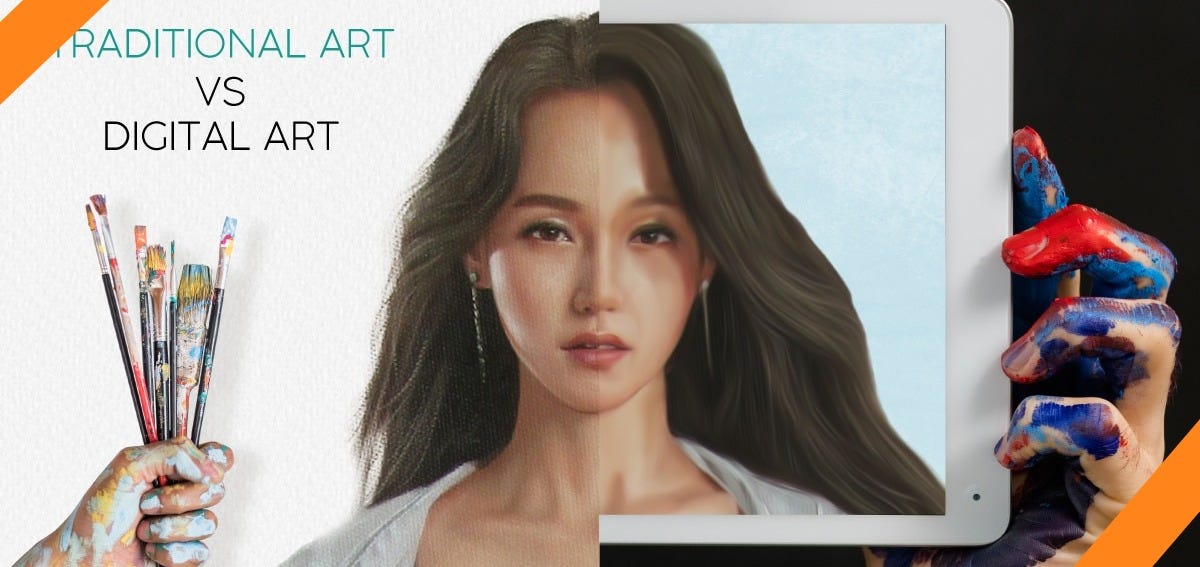With the mouse replacing the paintbrush, can hand-painted survive the digital wave?
Image: Tradition art V.S Digital art. Will Digital Art Replace Traditional Art Completely?Image by portraitflip.
Did you know. In just a decade, the market for digital illustration has nearly tripled, while the market share for traditional hand-drawn illustration is shrinking every year. The global market for digital drawing boards was $1,053.3 million in 2022. The market is expected to reach $1,328.4 million by 2029, according to a study by business research.
Will hand drawing really disappear? That's the question being asked by artists and audiences alike.
Image: The artist is painting. Image by flicker.
With the advent of internet technology, digital media, and AI technology. Artists with drawing boards depicting landscapes in the corners of parks, students with sketchbooks in art galleries, and bloggers sharing hand-drawn pictures on Instagram are slowly disappearing from our view.
Over the past decade in particular, advances in digital tools such as tablets, drawing software and digital tablets have led more and more artists to turn to digital creation. Does the popularity of digital really threaten the survival and legacy of traditional hand-drawn techniques?
After the introduction of photography, Maestro Engel once said, ‘Photography is truly a marvellous art, and I wish very much that I could paint so realistically, but no painter can do it.’ This undoubtedly reveals a concern about the potential threat photography posed to painting. Engel even attempted to join a group of artists in asking the French government to ban photography, claiming that it was an unfair form of competition for painting.
Image: Yellow lights and flowers painted by Toner Pigment. Painting by: Jiaxue
It is true that photographs are faster than paintings, if efficiency is anything to go by. But as far as painting is concerned, it is true that after the introduction of digital boards, the viability of hand-painting has been compressed. And hand-painted to consider the cost of painting materials and other consumables, but in terms of mass production, you only need a digital board and a computer can be basically once and for all, the digital board can be said to occupy a considerable advantage.
Video:Traditional painting is not as efficient as digital painting. Video by: ronillust
‘Ctrl+Z to directly turn back the clock.’
This is the absolute advantage of digital painting, drawing on paper is wrong, and then erase or overlay may also leave some defects, but digital painting can be a Ctrl + z directly back in time. A retraction would be a fresh start, realising that painting is a function of having pills of regret to take.
Image: Flowering tree in front of a building drawn on a digital board. Painting by Jiaxue
It is precisely because the board painting reduces the difficulty of using the tools, so in the actual work, the content of the picture must be on a higher level.
Traditional hand-painters can go to models for reference, take photographs of the material, and use sketching as the main way to complete the work. However, when it comes to drawing on digital board, most of the things that need to be drawn are things that are difficult to take from reality, or even don't exist at all, so you can only use your imagination as the dominant force, and draw with the impression in your own brain.
It is then necessary for the panel painter to have a strong spatial imagination and accuracy of perspective, to have an in-depth knowledge of optics and colour laws and to have the structure of the human body and other commonly drawn structures recorded in his mind, to ensure that he can draw them even if he cannot find a suitable reference.
So there are some people who will therefore think that anyone who draws by hand has a better foundation than someone who draws on digital board.
If Picasso would have used virtual reality, his work might have been similar to Nic Koller's.
Original image description:Heartfelt. Abstract deconstructed portraits of the heart indicated by the colour red.
On the surface, digital technology seems to be gradually freeing up the artist's ‘hands’, as painting is no longer dependent on mediums such as canvas and brushes; with the help of digital boards, touch screens, and a variety of digital software, the process of creation has become much more convenient, and the artist can easily modify his or her work. However, the changes brought about by digital technology go far beyond technical convenience and simplification of the creative process. More importantly, the spread of mobile technology and digital media has enhanced our interaction with the things we create, diversified the forms and expressions of artistic creation, and opened up unprecedented possibilities for artistic expression and understanding.
Digital painting offers creative freedom and efficiency, allowing artists to quickly experiment with different styles and techniques without the constraints of traditional materials. It also gives the artist a wider range of tools for expression, from the subtle adjustment of light and shadow to the precise control of colours, all of which can be achieved in one go on the screen.
Digital painting offers unprecedented creative freedom and efficiency, yet has its rise inadvertently undermined the status of traditional hand-drawn art and compromised artists' unique quest for self-expression?
Do you think digital painting can completely replace hand-drawn art? Why?








